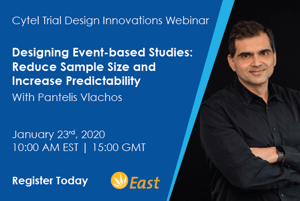
January’s Cytel Trial Design Innovations (CTDI) Webinar Series will feature Biostatistician and pioneering Bayesian trial-designer Pantelis Vlachos. Next week, Dr. Vlachos will speak on high-efficiency trial design for Event-Based Studies, particularly in oncology and cardiovascular trials. In this blog post, we offer a glimpse of Dr. Vlachos’ last CTDI Webinar (February 2019) on high-efficiency trial design using enrichment strategies.
Don't miss next week's webinar "Designing Event-based Studies: Reduce Sample Size and Increase Predictability"! Click on the button below to register.

Population Enrichment (PE) by definition is a prospective use of any patient characteristic to obtain a study population in which detection is more likely than in unselected population. PE can be prognostic in nature, which means it can identify high-risk patients based on biomarkers; or it can be predictive, where you can identify patients more likely to respond to a treatment or a combination of treatments.
The use of population enrichment has become increasingly appealing with rising costs of clinical trials and a decline in the discovery of blockbuster drugs. It appears that the pharmaceutical industry is gradually moving away from the “one-size-fits-all” idea for drug discovery.
Pantelis Vlachos, Cytel statistician and adaptive trial expert, shares his deep knowledge of population enrichment and thoughts on applying adaptive rules to achieve more flexible design scenarios in an insightful webinar. He explains the importance of using methods like population enrichment in helping us identify high responsive groups and detect treatment effect with smaller sample size. PE also plays a rescue role in the sense that failed molecules from one study may succeed in a different group, instead of in the whole population of patients. This occurred with Keytruda1, where the population was enriched by including only subjects with high levels of PD-L1.
Through a case study in angiosarcoma (AS), Pantelis presents a practical design that ultimately leads to greater power, shorter duration and smaller sample size; three essentials to resource optimization for high-efficiency trials
Watch the webinar to learn how to design an adaptive enrichment trial in Cytel’s comprehensive trial design solution, East® and understand how to deal with the special challenges of Event-driven trials when considering an adaptive enrichment design.

About Pantelis Vlachos
 Pantelis is Director/Strategic Consultant for Cytel, Inc. based in Geneva. He joined Cytel in January 2013. Before that, he was a Principal Biostatistician at Merck Serono as well as a Professor of Statistics at Carnegie Mellon University for 12 years. His research interests lie in the area of adaptive designs, mainly from a Bayesian perspective, as well as hierarchical model testing and checking although his secret passion is Text Mining. He has served as Managing Editor of the journal “Bayesian Analysis” as well as editorial boards of several other journals and online statistical data and software archives.
Pantelis is Director/Strategic Consultant for Cytel, Inc. based in Geneva. He joined Cytel in January 2013. Before that, he was a Principal Biostatistician at Merck Serono as well as a Professor of Statistics at Carnegie Mellon University for 12 years. His research interests lie in the area of adaptive designs, mainly from a Bayesian perspective, as well as hierarchical model testing and checking although his secret passion is Text Mining. He has served as Managing Editor of the journal “Bayesian Analysis” as well as editorial boards of several other journals and online statistical data and software archives.
Pantelis is a key contributor to the continuing development and training in the use of the East software package. In his upcoming webinar “Designing Event-based Studies: Reduce Sample Size and Increase Predictability”, he will describe methodologies to overcome challenges in designing event-based studies such as cardiovascular or oncology trials. These approaches can help you avoid unnecessarily prolonging a study, make better use of limited R&D resources, improve the experience of your patients, and help them more rapidly access effective therapies.

Reference
1. Kang SP, Gergich K, Lubiniecki GM, et al. Pembrolizumab KEYNOTE-001: an adaptive study leading to accelerated approval for two indications and a companion diagnostic. Ann Oncol. 2017;28(6):1388–1398. doi:10.1093/annonc/mdx076






 Pantelis is Director/Strategic Consultant for Cytel, Inc. based in Geneva. He joined Cytel in January 2013. Before that, he was a Principal Biostatistician at Merck Serono as well as a Professor of Statistics at Carnegie Mellon University for 12 years. His research interests lie in the area of adaptive designs, mainly from a Bayesian perspective, as well as hierarchical model testing and checking although his secret passion is Text Mining. He has served as Managing Editor of the journal “Bayesian Analysis” as well as editorial boards of several other journals and online statistical data and software archives.
Pantelis is Director/Strategic Consultant for Cytel, Inc. based in Geneva. He joined Cytel in January 2013. Before that, he was a Principal Biostatistician at Merck Serono as well as a Professor of Statistics at Carnegie Mellon University for 12 years. His research interests lie in the area of adaptive designs, mainly from a Bayesian perspective, as well as hierarchical model testing and checking although his secret passion is Text Mining. He has served as Managing Editor of the journal “Bayesian Analysis” as well as editorial boards of several other journals and online statistical data and software archives.